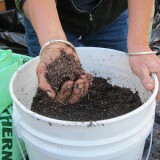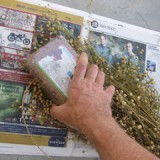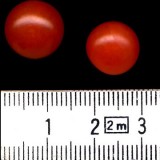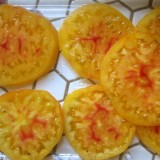
Seeds fermenting in water. Not pretty, but pretty important! The jar got shaken up while walking it outside for its photo op., so it looks a little cloudy and messy. In your jar, you should see a layer of scum on top of the water.
I can’t believe we haven’t posted about this before–it seems like we have, but I can’t find the post if this is so. Perhaps we wrote about it in one of our books…the old brain is getting foggy.
It’s easy to save seed from your favorite tomatoes. Seed saving in general is actually a little tricky. You can’t just save the seed from any old vegetable in your garden and hope that it will yield plants like the parent. Cross-breeding is an issue. Professional seed savers use all sorts of sacks and screens and boxes to ensure that busy bees or flirtatious winds don’t make romance happen where it ought not. Otherwise you get acorn squash crossing with melons and who knows what not. It depends on the type of vegetable you want to save seed from–as well as what else you’re growing around it.
Tomatoes, however, are a pretty safe bet for seed saving. They are self-fertile, and the structure of their flowers makes cross pollination difficult. Our seed saving Bible, Seed to Seed, says that there are only three types of open pollinated tomatoes that you can’t save seed from (without putting them in isolation):
- Currant tomatoes (L. pimpinellifolium)
- The potato leaved varieties of L. lycopersicum
- Any fruit born from double blossoms on Beefsteak-type tomatoes. Double blossoms are prone to cross-pollination. You can save seeds from fruit that came from a single blossom
Odd, but simple! You can basically save seed from almost any heirloom/open-pollinated variety you’re likely to be growing. You cannot save seed from hybridized plants. These are the type you are most likely to find in the nursery–plants bred for performance, not seed saving. This would include popular breeds like Early Girl and Better Boy and Sun Golds. If you’re not sure if your tomatoes are hybrids or not, just Google the name. The Internet is wonderful that way.
The process of saving tomato seed is simple. All you have to do is rot off the protective gel sack which surrounds each seed. This gel inhibits germination, keeping the seeds from germinating while still in the tomato. In nature, the gel rots off while the fallen tomato sits on the ground. Here, you will speed the process along with some water. In addition to removing the gel sack, this fermentation process also kills many seed-borne tomato diseases.
How to Save Tomato Seed
- Choose your best, tastiest tomatoes for seed saving.
- Scoop out the seed pulp and drop it into a jar. Or just squeeze a whole tomato over the jar. It’s best to just squeeze cherry tomatoes. (You can use food processor, too, if you’re doing big batches.)
- Pour a little water over the pulp. It should cover the pulp by say, 2-3 inches or so.
- Cover the container and let it sit for a few days (3 days, roughly–weather makes a difference), until white or grey mold forms on the surface of the water. If you do a big batch, you will smell the rot. Don’t worry about it–just keep the dogs away! Watch for the mold to form and continue on to the next step. The mold may be impressively fuzzy, or it may just be a slight opaque slick on top of the water. Don’t let it sit in this state too long, or the seeds will start germinating in their bath.* If you’re in doubt as to whether it is ready, it’s ready. Far better to stop a little early than to let the seeds accidentally germinate.
- Pour off the moldy water, reserve the seeds.
- Add clean water back to the seeds and give the water a swirl. Let it settle. Any bad seeds will rise to the top. If they do, pour them off.
- Strain the seeds with a fine strainer (a teas strainer is fine for small batches) and spread them out to dry. They need to dry on something which will wick water away, because it is important that they dry quickly–otherwise they might germinate. Coffee filters work well, as do pieces of window screen, or paper plates. Tomato seeds stick to paper towels, so if you use those you may end up having to plant the seeds on their little bits of towel.
- Once they are bone dry, transfer to envelopes or glass jars for storage. Be sure to label!
*I just lost a batch to germination. I blame the heat. It didn’t seem like they’d be fermenting that long, but after I drained my seeds I saw the tiny little white nubbins poking out of the seeds. Now I have to begin again. This is one reason why you should not wait ’til your last tomato to think about saving seeds. Also, this is a reminder to keep a close eye on your projects!
ETA: We’ve had some comments from what I’ll call the Paper Towel School of seed saving, and I thought I’d amend this post to point out that another method is to just spread some tomato pulp on a paper towel and let it dry out. The seeds will stick to the towel, so you store the whole towel and when planting time comes next year, you tear the towel into tiny pieces and plant the pieces. This does save steps. The method described above is the Official Method, and the method I’ve always used. I’ve not tried the paper towel thing myself, but it seems sensible. However, as I understand it, the fermentation process in the water bath method kills diseases, so it is considered good etiquette to put your seeds through this process if you plan to share them with others.
Also check out the comments for more on the mystery of cross-pollinating tomatoes!






Mrs. H,
Thanks for explaining that in detail. I usually just hear, “wash the seeds off and wait for floaters.” Your explanation is great, not vague at all. It really helps to hear “why” to do something.
Well that is a can of worms and I wonder if this will open a bit of a debate about cross pollination. There are many different anecdotes and experiences about this subject of tomatoes, heirloom or otherwise. Here in Tasmania I have experienced a great deal of cross pollination, not just from my own seed saving but also from others as well. I have to wonder if our insect population or bees are playing a part here.
As to seed saving certainly your method is a well accepted one but we simply choose best specimens and spill the ripe seed contents and spread on absorbent paper and leave to dry, fold writing the name on the paper and store, then simply plant torn pieces of paper and seed.
Hi Tanya. Indeed. Some tomato variegates will cross pollinate. You can sometimes predict this by examining the flowers. In some tomatoes the stigma pokes out beyond the flower petals–these are the type that will cross pollinate. Of course, the only way to assure that tomatoes will not cross pollinate is to grow them in isolation, in cages or bag the flowers. This can be a bit of a pain in urban places. And we’ve got two boxes of bees in our yard to add to the complications.
im lazy…i take some left over tomatoes and throw them around wherever in the general area i want them to come up the next year….this year (besides the cazy squash that showed up) the tomotoes came up everywhere….very good showing this year.
Wow PRB, that’s what I do too. Here I thought I was being “clever.” LOL
“This is one reason why you should not wait ’til your last tomato to think about saving seeds.” Mr. H, Truer words were never spoken. Thanks for all of your tips. Love the blog and the YouTube Video.
It’s true–it’s nature’s way! One of my favorite ways to propagate tomatoes is to transplant seedlings that pop up around where the plants grew the year before.
One thing I’d say that favors the more involved method is that it is considered good etiquette to ferment your seeds if you’re going to be sharing them with others (at seed swaps, etc.), because it really does knock out diseases.
Dee: Thanks!
thank you Mrs H for the etiquette tip!!! (i need LOTS of etiquette tips – not just re: tomatos!) i will remember and this post drew me to it just cuz i love fermenting….so thank you – your response made it stick even more solidly in my mind…
and Dee – i like clever better than lazy!
That’s weird. I’ve grown L. pimpinellifolium (originally from feral plants in Hawaii) for years, and they’ve never crossed with anything. Or at least they look and taste the same.
I save tomato seeds like Tanya–just squish seeds from a very ripe tomato onto a paper towel, let it dry, and fold it up. Seems to work fine.
Wow. Thanks! So I’ve been doing it (really) wrong for years! No wonder not all my seeds germinate! I usually just put ’em in a bowl with as little gel as possible and let them dry out, then pick them out of the sticky dried up mess and bag them. I’ve had decent luck getting germination over the years, but I think the germination rate per seed I plant could be higher.
This year I rinsed them off in a mesh sieve in water and let them dry on paper towels. I plan to cut up the paper towel and plant the seeds that way in the spring.
Next batch I prep for next year (later this week), I’m going to use your method. Thanks again!
Thanks for the explanation. if you have any idea connected with agriculture Please drop it to my email.
thanks a lot
babu
Dear Mrs. Homegrown,
Thank you for your email. Could you also share a website address that i order seeds from Turkey ? Thank you in advance.
I know this might seem like a stupid question but how deep do you Plant the seeds ? can they take full sun or need some shade? Im in Nevada and would like to grop some in containers Thanks in advance !
Plant them about 1/4 inch deep — or put them on the surface and sprinkle a little soil on top. Keep it wet! Tomatoes love sun and heat but in Nevada I think they would appreciate some shade–especially if you’re growing in pots, which heat up and dry out fast. I don’t know if you’re thinking about starting your plants right now or later, but I believe desert growers start their tomatoes earlier in the year, so they are mostly done by the time the worst of the summer heat settles in. There’s nothing to stop you from trying to plant now, but if you find they don’t do well, try again next spring. Consult local sources to find out when the best time to plant is in your area.
I do it the lazy way, too. In fact, some of the best tomatoes I’ve grown came from store-bought grape tomatoes. They started drying up because I couldn’t eat them fast enough, so I just chopped them up and stuck the bits of tomato with the seeds in them into the ground. Got lots of identical tomatoes (which taste great). And the next year little tomato plants popped up all over. I just left them there to grow and heaped a little more good soil around them, since they’ll grow roots from their stems. Got some great cantaloupe and acorn squash from the scraps I tossed in the compost pile as well.